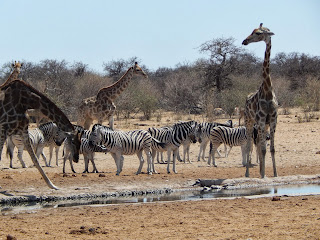To celebrate the end of the year, I present an updated version of my #2 blog post of the year. As #1 was about summer travel accessories, I am opting to reprise that once the weather gets warmer.

 Despite the fact that I have traveled to more than 50 countries on six continents
Despite the fact that I have traveled to more than 50 countries on six continents (I am missing Antarctica), preparing for a trip to an unknown and faraway destination is still perplexing. As I prepared for my trip to Namibia this fall, I pondered, among other things, logistics, medications, documentation, and fashion. Here's a list of 9 things I had to figure out before going to Africa...and things you should think about as well before taking off to distant lands.
1 Do I need a visa? Official media are supposed to have visas to enter Namibia, but your garden variety American tourist does not. Although I went to Namibia to write about
The Jewel of the Desert train, I opted to go visa-less (please, Namibia's version of Mr. E. Snowden, don't tell on me). After all, as a travel writer, my mission is to have the
same experience as regular travelers do. So, no visa for me, although I brought a VISA card...and an ATM card to boot.
2. Do I need more pages in my passport? Apparently, the answer is yes. For some reason, Namibia requires everyone to have 4 to 6 blank passport pages. As I am on Year 9 of a ten-year passport, I only have one blank page left. Should I wing it? According to a colleague at
Solimar International, a firm that does tourism consulting work in Namibia, the answer is a definite no. Said colleague spent the better part of the day in Windhoek Airport, while one of his co-workers had to zoom over to the local American Embassy for pages. Thankfully, I live in Washington, DC (how often do you hear someone say that these days?), very close to the National Passport Center. So I ran downtown and spent $142 to add passport pages (versus $170 for a new passport).
3. Do I need shots or malaria pills? Shots--no. Malaria pills? It wasn't clear. I opted out and I was fine. Many of my fellow travelers who took the pills got very sick on the train. The train's doctor ascribed their flu-like symptoms to the malaria medication. So, pick your poison.
4. What about money, honey? The Namibian dollar is on par with the South African rand, and the latter is accepted everywhere in Namibia. As the Namibian dollar is not easily convertible on the world market, best to stock up on rand. That way, leftover money can be exchanged back into US dollars.
 |
| www.abercrombieandkent.co.uk |
5. What do I wear? I am oft vexed regarding visitor vestments, particularly when I travel to the Middle East or Africa. When I went to Morocco in 2001 (geographically in Africa; culturally, it could be argued, the westernmost part of the Middle East), I had a two-fer on my hands. I was
verklempt, as everything I owned was too tight, too short, or too colorful. I ended up purchasing a bunch of long, oversized
schmatas. The Moroccan men, unstereotypically, paid me no mind, but the women there didn't seem to appreciate my valiant efforts to mask my feminine wiles. Methinks hunting for safari clothing will be easier, but I still must find items that will cover me up (mainly to ward off bugs and to protect against the scorching sun).
6. How do I allay the heat? As frequent readers will recall, during my most recent adventure,
I swooned in the Forbidden City and had to spend the night in a Beijing ER. As a result, I am stocking up on
electrolytes, bringing a huge sombrero, and slathering on suntan lotion.
7. What unusual items do I need? This type of journey requires gear not usually included on my packing list. Bug spray; a flashlight; a water purifier; a beanbag (to serve as a camera stabilizer in jittery jalopies); and the aforementioned electrolyte tablets are some of the extras I will stow.
8. How am I going to survive the 18-hour flight? Try to get an aisle seat in Economy Plus or an emergency row seat. I got both on my outbound flight on
South African Airways from Washington, DC to Johannesburg--an 18-hour jaunt. I was able to stretch my legs and do yoga in my seat space. However, on the way home, I was left with a non-emergency aisle, which, for an 18-hour stretch, is uncomfortable any way you slice it. One thing that helped immensely on my 14-hour flight to Beijing in the spring--using my
BackJoy Posture +. Sadly, I didn't bring it on my Africa trip, and my lower back paid the price.
9. How many days will it take me to get over jet lag? Fortunately, the time difference is, surprisingly, only 6 hours. Therefore, spending my first night in Africa at the
Intercontinental Hotel at the Johannesburg Airport (smart move) and my second night at the
Okapuka Ranch near Windhoek left me well-rested when my official exploration began.
 Say you are wandering through Meridian Park, located in northwest DC. Suddenly, you stumble upon a statue of a dude flanked by a twosome representing law and democracy. Quick, who's that dude? It's James Buchanan. President #15 was hardly a gem--he’s rated among the worst by historians. The pre-Civil War leader is noted for doing little to prevent the growing schism between North and South. Nonetheless, the country’s only bachelor president gets a statue in the nation's capital, albeit hidden away in a place most visitors will never get to.
Say you are wandering through Meridian Park, located in northwest DC. Suddenly, you stumble upon a statue of a dude flanked by a twosome representing law and democracy. Quick, who's that dude? It's James Buchanan. President #15 was hardly a gem--he’s rated among the worst by historians. The pre-Civil War leader is noted for doing little to prevent the growing schism between North and South. Nonetheless, the country’s only bachelor president gets a statue in the nation's capital, albeit hidden away in a place most visitors will never get to.






















